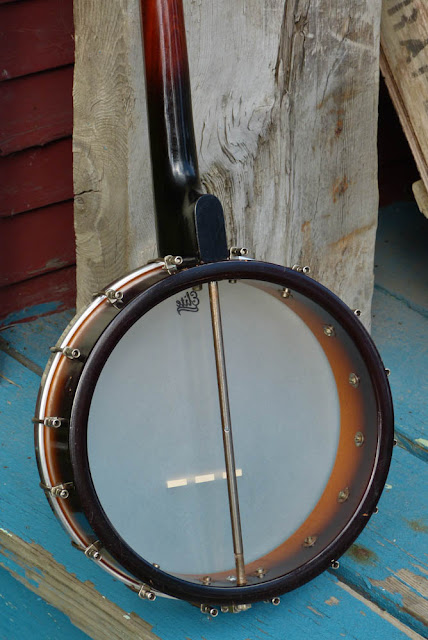1930s Gibson-made Kalamazoo KTB Tenor Banjo
Kalamazoo-branded Gibson products are always simple, practical, and sturdy. That's how I'd describe this one -- but it also has a nice fundamental sound and a great neck. The KTB model originally would've also had a resonator, too, but this one's resonator is long-missing. This has Gibson's standard-ish 22 3/4" long scale, a single coordinator-rod setup through the rim, and a standard 11" head size with "raised wooden lip" rim rather than an added tonering.
Work included a light fret level/dress, new tuners, new bridge, new tailpiece, new head, cleaning, and setup. It plays perfectly (1/16" at the 12th fret action), the neck is straight, and it's currently strung for DGBE ("Chicago") tuning but the compensation at the bridge also allows for standard CGDA, too.
This came to me with a newer Remo Renaissance head on it but I swapped it out to an Elite because I think the logo on the Elite-branded Renaissance heads looks a little slicker for matching with the period aesthetic.
The neck is mahogany and has a sunburst finish applied. The board is Brazilian rosewood and the nut is ebony. All the hardware is original save for the tuners (the ferrules are original, though), bridge, head, and tail.
Pearl dots. The neck has a quick C shape to it.
I compensated the new Grover bridge for better pitch up the neck and also added a No-Knot tailpiece to replace the original mandolin-style tail that was missing its cover. That reads as an improvement, by the way.
The rim is maple with a sunburst finish and the single coordinator-rod setup allows easy action adjustment. Tighten it under the tailpiece to lower action -- loosen it to raise. This is extremely functional and very practical for anyone who takes their banjos all over the place.
These new Kluson repro-style tuners are certainly not original but did replace some under-the-weather 60s guitar-style tuners that had before replaced the original friction pegs that would've been on this when it was made. I find these Kluson-style tuners very functional, practical, and stable.
Note also the small hairline crack/chip-out area under the bottom left tuner -- it's been glued-up but it's there.
The last owner left out the adjuster nut on the inside of the rim -- and so did I. It's only really necessary if you want a fairly shallow angle on the bridge and so have to force the neck forward.
There are four of these little attachment points that would've, undoubtedly, held anchors for the resonator that's missing.
The original setup had a bracket on the coordinator rod adjustment area to hold the tail. I modified this setup by adding a vintage "endbolt" to hold the tail instead -- thus making rod adjustments a lot easier.

















Comments